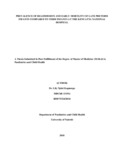| dc.contributor.author | Kaguongo, Lily N | |
| dc.date.accessioned | 2019-01-31T05:38:27Z | |
| dc.date.available | 2019-01-31T05:38:27Z | |
| dc.date.issued | 2018 | |
| dc.identifier.uri | http://hdl.handle.net/11295/106079 | |
| dc.description.abstract | Background: Late preterm neonates account for 62% of all preterm births in Kenyatta National Hospital (KNH). They are often the size and weight of some term neonates. Because of this, they may be treated by parents, care givers and health care professionals as term neonates as they are thought to be developmentally mature and at a low risk of morbidity. They are often managed in newborn level 1 (basic) nurseries or remain with their mothers1 although they are physiologically and metabolically immature2-6 and as a consequence have a higher risk than term babies of developing medical complications that result in higher rates of morbidity and mortality.6-8
Study Utility: Without new developments in the prevention of preterm births, it is important to focus on improving care of the late preterm and prevent readmission.9. No studies have been done to determine the prevalence of readmission of late preterms in Nairobi and its surroundings
Primary Objective: To compare the prevalence of readmission of late preterm neonates versus term infants born in the Kenyatta National Hospital.
Secondary Objectives: To determine the factors associated with readmission of late preterm neonates and term infants.
To determine the mortality and morbidity of late preterm infants and term who are readmitted within 6 weeks of delivery
Methodology: A short longitudinal cohort study was carried out at KNH, Nairobi, Kenya. Late preterm infants aged between 34 weeks gestation to 36 weeks and six days gestation and term infants aged between 37 weeks – 42 weeks gestational age were identified using the new Ballard Score in the KNH maternity and labour wards. The neonates together with their mothers or care givers were consecutively recruited until the desired sample size was achieved. Recruited mothers or caregivers initially answered questions from a questionnaire administered before the initial hospitalization discharge. They were then followed up by a phone call once weekly where required information was gathered by use of a follow up questionnaire for a period of 6 weeks.
Data analysis: Data was collected and entered into a clinical records form by the primary investigator. The data was subsequently checked and entered into a computerized data base using STATA version 23. Continuous variables were analyzed using mean and standard deviation for normally distributed variables. Percentiles and mean will be used for normally distributed variables and categorical variables presented as frequencies and rates.
Results: One hundred and two patients were enrolled in each group. Overall 27 0f the 102 late preterm neonates were readmitted representing 26.5% compared to 9 term infants (8.8%) of
ix
readmitted term neonates. Our study showed that among late preterm infants, those who stayed in hospital less than 48 hours during the initial hospitalization had significantly higher readmission rates compared to those with longer hospital stays. (P value 0.05). Duration of initial hospital stay was not statistically significant among the term neonates. However, term infants born to single mothers were more likely to be readmitted than those born to married mothers. (P value 0.003). Breast feeding, maternal pregnancy and delivery complications, birth order and mode of delivery were found to not be significant risk factors for readmission in both groups. The most common morbidities among the readmitted late preterm infants were neonatal sepsis (92%), acute kidney injury (55%) and hyperbilirubinemia (32%) while neonatal sepsis (67%) and hyperbilirubinemia (55%) were the most common morbidities among the readmitted term infants.
Conclusions: Late preterm infants had higher rates of readmission compared to term infants with the most common morbidities being neonatal sepsis, acute kidney injury and hyperbilirubinemia among late preterm infants. Neonatal sepsis and hyperbilirubinemia were the most common causes of readmission among term infants. A short duration of initial hospital stay was associated with readmission among late preterm infants while term infants born to a single mother were more likely to be readmitted.
Study limitations: Some study participants were not reachable and some were lost to follow up. The study also depended on the willingness of participants to provide adequate and truthful information during the follow up phone calls.
Key recommendations: Hospital discharge of late preterm neonates should be delayed and a full assessment done before discharge to identify any morbidities. Mothers of late-preterm infants should be also be educated on how to evaluate feeding success and to assess for danger signs of sepsis | en_US |
| dc.language.iso | en | en_US |
| dc.publisher | University of Nairobi | en_US |
| dc.rights | Attribution-NonCommercial-NoDerivs 3.0 United States | * |
| dc.rights.uri | http://creativecommons.org/licenses/by-nc-nd/3.0/us/ | * |
| dc.subject | Prevalence of Readmission and Early Mortality of Late Preterm Infants Compared to Term Infants | en_US |
| dc.title | Prevalence of Readmission and Early Mortality of Late Preterm Infants Compared to Term Infants at the Kenyatta National Hospital | en_US |
| dc.type | Thesis | en_US |
| dc.description.department | a
Department of Psychiatry, University of Nairobi, ; bDepartment of Mental Health, School of Medicine,
Moi University, Eldoret, Kenya | |



